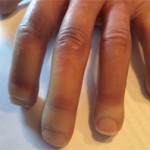A member of the basic science faculty presented the preliminary results of a scleroderma study in which several of the key cytokines were down-regulated in a mouse model. I took out my notepad and copied the blackboard presentation for later review. After medical school, four years of an internal medicine residency and six years of primary care medical practice, I was back in school, learning a new language.
That night, a strange image came to mind as I dreamed about diffuse scleroderma and other complex immunologic disorders. I was in a glider cruising low over New York City, low enough to make out clusters of pedestrians waiting for the light to change. Trucks spewed smoke, taxis beeped, traffic police blew their whistles. Overhead, electrical wires surged with power. Beneath the streets, hidden from view, fluids coursed through water and septic lines, flushing the system. Somewhere, a social worker, policeman or construction worker was hard at work, endlessly at work, attempting to fix a broken life or a broken line.
Like a modern city, the human body’s immune system is held together by complex invisible threads. Regulators of behavior are not all or nothing; they exert their effect on the body by the ebb and flow of chemical messages. Helper T cells, suppressor T cells, killer T cells, dendritic cells—all allow the system to up-regulate and down-regulate with astounding precision. When researchers discover a new thread, they characterize it and seek to understand how this new variable fits into the larger system. One thread leads to another thread, another interconnected system. Over time, a clearer picture is emerging, but as yet, the picture is incomplete, and at times, paradoxical: You pull on one thread, and the seam closes. You pull on another thread, and a sleeve falls off.
Back to the Present
That was in 1991. Since that time, dramatically effective drugs—but no cures—have been developed for many immune-mediated diseases: rheumatoid arthritis and lupus, ankylosing spondylitis and vasculitis, the list grows yearly. But the enigma of diffuse scleroderma remains. Dr. Medsger at the University of Pittsburgh and others around the globe have devoted entire medical careers to chasing down leads, performing clinical trials, incrementally improving the care for this dreadful disease. They’ve made a difference, a critical difference in the lives of their scleroderma patients. But the answers have been slow in coming.
A recently published randomized controlled trial of tocilizumab in systemic sclerosis and the 48-week, open-label extension study may offer new hope for scleroderma patients.7,8 As myeloablative autologous stem cell transplantation is refined and toxicities are reduced, this approach may also offer additional treatment options for patients with severe disease.9 Perhaps, we are on the cusp of finally achieving consistent, effective management for this horrific disease.



